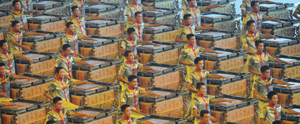Fur coat and no knickers
Clive Parkinson sees the danger of arts/health practice becoming a “bland cultural sub-species, offering the marginalised a transient feel-good factor”, watered down to fit the paymasters’ needs

I guess every century has its fair share of trauma, both natural and as a result of our meddling hand. It’s perhaps in the shadow of our ongoing ‘deficit crisis’ that thinking about our arts/health agenda might best be framed, for if the work has got any cultural value, isn’t it in a crisis where we’ll show our mettle? John Pilger tells us that our current financial state is “…not remotely a crisis. When Britain was officially bankrupt at the end of the Second World War, the government built its greatest public institutions, such as the National Health Service and the arts edifices of London’s South Bank.” This observation is adroit and relevant to our shared agenda, but Pilger also points to the vanity of artists and asks where their voices are whilst the government slash and burn to fulfil their policy objectives?
Art in the public realm, in the minds of people outside the world of culture and the arts who are facing uncertain futures, is an irrelevance, meaningless decoration and a waste of resources: all fur coat and no knickers. You only have to look at the sculpture by Juan Ripollés, at the new Castellon Regional Airport in Spain, to see how both the media and politicians alike enjoy nothing more than a badly conceived project to hide behind. A €300,000, 24m-high, 20-ton copper statue has been dedicated to the infamous and allegedly corrupt politician, Carlos Fabra. His gurning, patinated face will welcome people to a brand new airport that few people use, in a country teetering on the brink of recession and with the highest unemployment rates in 17 years .
Surely this is public art at its most banal and most irrelevant?* Whilst Pilger calls for artists to rage against the hypocrisy of politicians and morally bankrupt societies, it seems art in the public realm so often reverts to the default ‘wow’ factor; a quick-fix opiate to keep the people happy. A 37-ton, 50 foot high spider; a 20 foot tall elephant; or a Little Giant Girl: like Talos, the bronze giant from Jason and The Argonauts, these are sensational, terrifying and appealing. But, like any drug, you just crave more and its got to have a bigger hit each time. Just think fireworks: how can you improve on the previous display? Surely the ultimate progression involves the split atom and is altogether more participative.
We’re frequently told that the arts offer us something as a counter-blast to this ‘fast-food, quick-fix smiley culture’, but through their addictive gloss and glamour, aren’t they often just a reflection of, and not a reaction to, the here and now? And the ONS, whilst charged with measuring our progressive unemployment, is also commissioned to measure the nation’s wellbeing and come up with the next measurement of happiness. Isn’t that what we’re all searching for – a prescription for a diversion from this mess? Isn’t this what this arts/health movement’s all about – doling out cultural quick-fixes for a fractured society?
If that’s the case, aren’t we manipulating our practice to fit the criteria for the next funding application: watering down the work so it fits the paymasters’ needs and corporate social responsibility profile? This arts/health field is in danger of becoming some bland cultural sub-species, offering the marginalised a transient feel-good factor; some base level cultural instrumentalism for the impoverished, whilst the regular cultural consumers suck up the high-fat, spoon-fed nectar of the acceptable avant-garde.
So, what are our values – and are they just dictated by the next government spending review, or else a shift in Arts Council priorities? Judging by the coalition Government’s desperate bid to hijack the wellbeing agenda and reduce the populous to happy, passive, measurable units, there needs to be serious discussion about both what we understand as our shared (and opposing) values, and what others deem to be our quantifiable worth, both economic and social. I never thought I’d be citing Alastair Campbell in an article on arts and health, but his recent writing on happiness and depression acknowledges the hard work, pain and anxiety that add up to the fully-rounded human being that can honestly look back on a life well-lived and consider that they may have experienced transient happiness as part of something far more complex; that fraught experience of being human.
So here’s the nub. In a world of sedated citizens, it just takes a hairline crack to expose the potential of life beyond the confines of the superficial facade of order. Witness the simmering anger at institutionalised corruption, bursting like lanced boils across the surface of this “goodly frame the earth.”**
Join the Discussion
You must be logged in to post a comment.